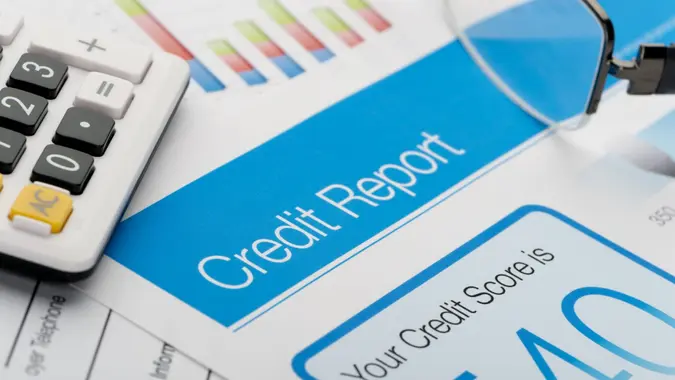Why Are My Credit Scores Different? Here’s What You Need To Know

Commitment to Our Readers
GOBankingRates' editorial team is committed to bringing you unbiased reviews and information. We use data-driven methodologies to evaluate financial products and services - our reviews and ratings are not influenced by advertisers. You can read more about our editorial guidelines and our products and services review methodology.

20 Years
Helping You Live Richer

Reviewed
by Experts

Trusted by
Millions of Readers
Your credit score isn’t assigned by banks or credit issuers. Instead, credit bureaus, such as Equifax, Experian and TransUnion, give you a number based on factors like payment history, amounts owed, length of account history and more.
Each bureau collects and reports data independently. In other words, they don’t share your information. Not all credit bureaus have the same information. This can lead to a different score with each bureau.
Different Credit Scoring Models
There are two scoring models for personal credit scores:
The most widely used credit score is FICO. It examines five factors, each of which makes up a different percentage of your overall score:
- Payment history: 35%
- Credit utilization: 30%
- Average age of accounts: 15%
- Credit mix: 10%
- New credit: 10%
Then there’s VantageScore, an alternative model with slightly different calculations. VantageScore factors include:
- Payment history: 41%
- Depth of credit: 20%
- Credit utilization: 20%
- Recent credit: 11%
- Balances: 6%
- Available credit: 2%
In short, FICO is more important than VantageScore because it’s the most widely used model for approving your application.
Why Are My Credit Scores Different?
There are several reasons you have a different credit score from each credit bureau.
Differences Between Credit Bureaus
It’s not that the three major credit bureaus aren’t reliable. They score you based on the information that they have. The problem is that they don’t always have the same information.
Here’s why: Credit bureaus rely on credit card issuers to report your activity to them. Some credit card issuers, like Capital One, report to all three credit bureaus. Not all issuers do this, however. Some report to just one or two. Because of this, one credit bureau may see lots of great payment history and low credit utilization, while another may have no idea how you’re using that particular card.
Something as simple as a bit of missing data can cause your credit score to vary greatly across different sites.
Different Scoring Models Used by Websites
Sites use specific scoring models based on their risk assessment needs. FICO and VantageScore offer different versions to lenders.
For example, your FICO score may be based around FICO 8, 9, 10 or 10T.
Timing of Credit Report Updates
Your credit report isn’t updated in real time. Lenders generally report your activity to the credit bureaus once per month. That means your credit score is usually behind.
For example, if you’ve had a high credit utilization of 60%, your credit score is likely suffering. But even if you were to pay your credit cards off today, you might not see a change in your credit score for weeks.
Fortunately, credit bureaus typically update your credit score quickly after your lender has contacted them.
Soft vs. Hard Credit Inquiries
When you apply for a line of credit, the lender may do a hard inquiry or hard pull to take a look at your credit score. This can make your credit score temporarily go down a few points.
A soft inquiry or pull happens during background checks for apartments or you look at your own credit score — which you should do regularly.
How To Interpret Your Credit Scores Accurately
Here’s an overview of how to evaluate your credit score.
Focus on Score Range, Not Exact Number
Your exact credit score doesn’t matter as much as the “range” your score lives in. Lenders will often approve you based on your score range.
FICO has the following five ranges:
- 800 to 850: Excellent
- 740 to 799: Very Good
- 670 to 739: Good
- 580 to 669: Fair
- 300 to 579: Poor
Your credit score can fluctuate, but as long as you’re not dropping down to a lower range, everything’s fine.
For example, if your credit is in the “good” range, you won’t have much of a problem opening just about any credit card. If it’s in the “fair” range, you’ll be relegated to mostly credit-builder credit cards.
Check Scores from a Trusted Source
When checking your credit score, use official sites like Experian.com and TransUnion.com. You can also check out AnnualCreditReport.com, which gives you a free report each year.
Many banks and credit cards also offer credit monitoring, giving you a monthly or quarterly snapshot of your score. You can find it in your online account.
Monitor Changes Over Time
Banks and credit bureaus do their best to keep you informed of fraud, but the strongest preventative measure you can take is to manually keep an eye on your accounts.
You don’t have to pore through transactions every day. Focus on trends instead. If your credit score sharply decreases, take a look at your credit report to find any anomalies.
For example, a new account may have been fraudulently opened in your name. Or you may have somehow forgotten to make a payment on a credit card.
How To Maintain a Strong Credit Score Across All Platforms
To keep your credit score strong, you need to understand which factors impact your score the most, namely:
- Payment history: The single best thing you can do for your score is to pay your bills on time.
- Credit utilization: Experts recommend that you keep your debt below 30% of your total available credit.
- Average age of accounts: Avoid opening too many new accounts at once.
Again, monitoring your own accounts regularly is a critical, if annoying, part of maintaining a strong credit score.
Credit Scores and Why They're Different: FAQ
Here are the answers to some of the most frequently asked questions about why your credit score might be different on different sites.- Why is my FICO score different from my VantageScore?
- Your FICO score is different from your VantageScore because they are weighted differently. Both examine similar aspects of your credit profile, but each factor makes up a different percentage of your overall score.
- How often do credit scores update?
- Credit scores may be updated multiple times per month. Creditors tend to report your activity to the credit bureaus once per month, but they don't do it on the same day. Once a credit bureau has received new information about your activity, it will update your credit report -- and your credit score.
- Which credit score do lenders use the most?
- Lenders use the FICO credit scoring model the most when it comes to approving a loan. VantageScore is often used for prequalification or preapproval, for a credit card or an apartment rental, as examples.
- Can I have different credit scores for different types of loans?
- You can have different credit scores for different loan types. Lenders may pull previous FICO models for mortgages, for example. FICO can even tweak scores based on the account you're trying to open. For example, FICO Auto Scores examine your standard FICO score and then weigh it against the unique risk involved with auto loans.
- How can I check my credit score for free?
- You can check your credit score for free by visiting sites like Credit Karma and Credit Sesame. Opening an account is free, and your score will be updated periodically throughout the month. You can also check your bank or credit card's online account -- many of which offer FICO score monitoring as a free benefit.
 Written by
Written by  Edited by
Edited by 






















